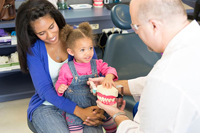Kool Smiles represents the spirit and success with which DSOs are caring for kids and adults on Medicaid and CHIP
 For the solo dental practice, making ends meet caring for Medicaid and CHIP (Children’s Health Insurance Plan) patients can be tough. Many practices walk away from this segment of the population. As a result, many patients are underserved. They either don’t see a dentist at all, or they end up in the hospital emergency department for emergency care.
For the solo dental practice, making ends meet caring for Medicaid and CHIP (Children’s Health Insurance Plan) patients can be tough. Many practices walk away from this segment of the population. As a result, many patients are underserved. They either don’t see a dentist at all, or they end up in the hospital emergency department for emergency care.
Dental services organizations are well positioned to take the lead in caring for patients on Medicaid and CHIP. Kool Smiles is an example. With 126 dental practices in 15 states and the District of Columbia, Kool Smiles – which is affiliated with Benevis, a practice services company – sees an average of 2 million Medicaid patient visits per year. Approximately 90 percent of its patients are Medicaid or CHIP enrollees.

“By harnessing economies of scale, we are able to streamline the claims process, achieve lower equipment and supply costs, and leverage our information technology platform to better absorb low Medicaid reimbursement rates, and still operate profitably and efficiently – all while providing more conservative care than the average dentist who sees Medicaid patients,” says Dale Mayfield, DMD, chief dental officer.
“Kool Smiles is able to provide more cost-efficient dental care to a larger number of Medicaid patients in part because our practice services company, Benevis, has streamlined the Medicaid claims process for our dentists,” he continues. “Many private dental practices are unable or unwilling to accept Medicaid patients because the reimbursement rate still lags far behind private insurance, and the Medicaid claims process is so burdensome that it would require extra, dedicated staff just to manage the administrative aspects. On top of these challenges, it’s difficult – if not impossible – for solo and small practices seeing a limited number of Medicaid patients to absorb the losses from missed appointments, which tend to be at a much higher rate for Medicaid patients than for commercial patients.”
The most recent estimates from the Centers for Medicare & Medicaid Services (CMS) show that more than 55 percent of children on Medicaid did not go to a dentist in 2014, points out Mayfield. A 2015 Health Affairs study showed that even though Medicaid expansion has resulted in increased dental coverage, it has had no impact on decreasing emergency room visits for dental care, because there are not enough dentists willing to accept Medicaid patients. “These analyses suggest that access to care, rather than coverage alone, is what makes the difference,” he says.
Affordable Care Act
The Affordable Care Act has presented its own set of challenges.

Andrew Oreffice, senior vice president, Benevis, points out that according to CMS data, more than 1.9 million additional Medicaid children had a dental service in 2014 than in 2012. With the increased focus on coverage brought by the Affordable Care Act, the number of children age 20 and under on Medicaid grew 8.5 percent over this time period, he says.
“Given the increase in the number of children who are seeking Medicaid dental care, the shortage of dentists who are willing and able to accept Medicaid patients has become even more pronounced,” he says. “Some states – Maryland, Virginia, and Texas, for example – have been successful in building up a robust network of dental providers to treat these patients. Other states – Florida, California – have struggled with providing adequate and cost-effective dental care to children through their Medicaid programs.”
Despite the fact that pediatric dental coverage is considered an essential health benefit (EHB) under the Affordable Care Act, the gains for dental coverage for children covered by the ACA’s state- and federal-facilitated marketplaces have been mixed, says Oreffice. Depending on the state, pediatric dental benefits may be offered through one of the following:
- A qualified health plan (QHP) that includes dental coverage.
- A stand-alone dental plan purchased in conjunction with a qualified health plan.
- A contracted/bundled plan.
“However, subsequent federal guidance treats pediatric dental benefits differently from the other EHB categories, which has created unique challenges in implementing a guaranteed pediatric dental benefit,” says Oreffice. “For example, the cost of a pediatric stand-alone dental plan is not included in the calculation of a family’s federal tax credits, and there is no federal requirement that individuals purchase a stand-alone dental plan. So, if an enrollee opts to purchase stand-alone dental coverage, he or she is responsible for the full premium, which averaged $27 or more per month in 2015, according to the National Academy for State Health Policy.”
Insofar as Medicaid for adults is concerned, the American Dental Association Health Policy Resources Center estimates that approximately 8.3 million adults were eligible to gain Medicaid dental benefits in 2014 as a result of expanded Medicaid eligibility and increased enrollment efforts – two aspects of the Affordable Care Act. An estimated 2.9 million were eligible to gain extensive benefits, with an additional 5.4 million eligible to gain limited benefits.
Still, only about 15 states offer extensive coverage for adult dental services in Medicaid, says Oreffice. “Medicare does not cover most dental services, and most private dental coverage is offered through stand-alone dental products that are separate from medical plans. Overall, this has resulted in more than 2.5 times as many Americans going without dental coverage as medical coverage.”
The dental home
 Mayfield believes that Kool Smiles has been able to provide conservative and cost-effective care to Medicaid dental patients in large part because it has been successful in establishing dental homes for patients who have historically lacked regular access to dental care.
Mayfield believes that Kool Smiles has been able to provide conservative and cost-effective care to Medicaid dental patients in large part because it has been successful in establishing dental homes for patients who have historically lacked regular access to dental care.
A Benevis Foundation study by Washington, D.C.-based health economics and policy consulting firm Dobson DaVanzo & Associates, released in February 2016, reports that Kool Smiles dentists delivered more conservative care than others to Medicaid patients. They performed 15 percent fewer services overall, including 40 percent fewer extractions and 39 percent fewer pulpotomies to Medicaid patients.
“Our conservative care rates are a strong indication of the improved oral health of our Medicaid patients over time,” says Mayfield. “When children have consistent, regular access to preventive dental care, their need for more expensive restorative and operative procedures decreases over time.
“When Kool Smiles has been in a community for four years, our patients’ average number of dental procedures decline by 28 percent – a clear indication of improved oral health. The cost-savings to state Medicaid programs are a result of our ability to successfully decrease the number of services needed and improve the oral health of our Medicaid patients over time.”
Even so, establishing a dental home for Medicaid patients isn’t easy.
Adult Medicaid patient volumes have remained steady among Kool Smiles practices, says Oreffice. However, “the limited dental benefits that most states provide do not facilitate the establishment of dental homes for adults. The predominant Medicaid dental coverage is ‘emergency only,’ which only covers problem-focused exams and extractions. Routine preventive dental care for adults – dental check-ups and cleanings – are not covered by the Medicaid program.”
Educating the community
“Educating community members about the dental coverage benefits available to children through state Medicaid and CHIP programs can be challenging for local and state authorities and outreach organizations, especially because the enrollment process is quite complex and varies by state,” says Mayfield.” Our call center staff are trained to answer patients’ questions about Medicaid eligibility and to direct them to the appropriate resources for Medicaid enrollment in their state.
“We also partner with community organizations at the local level to increase awareness around the importance of oral health. For instance, we have developed age-appropriate dental health lesson plans for K-5 classrooms, which teachers can download for free on our website. Kool Smiles Dental Lesson Plans help children understand how soda, candy and certain foods can lead to oral health issues like cavities and toothaches. Our lesson plans include printable activity sheets, experiments, and games to help children learn about the benefits of good oral health.”

